Phone: (585) 902 2822
Email: info@jimmysuits.com
Tailored Elegance, Timeless Confidence.
Tailored Elegance, Timeless Confidence.
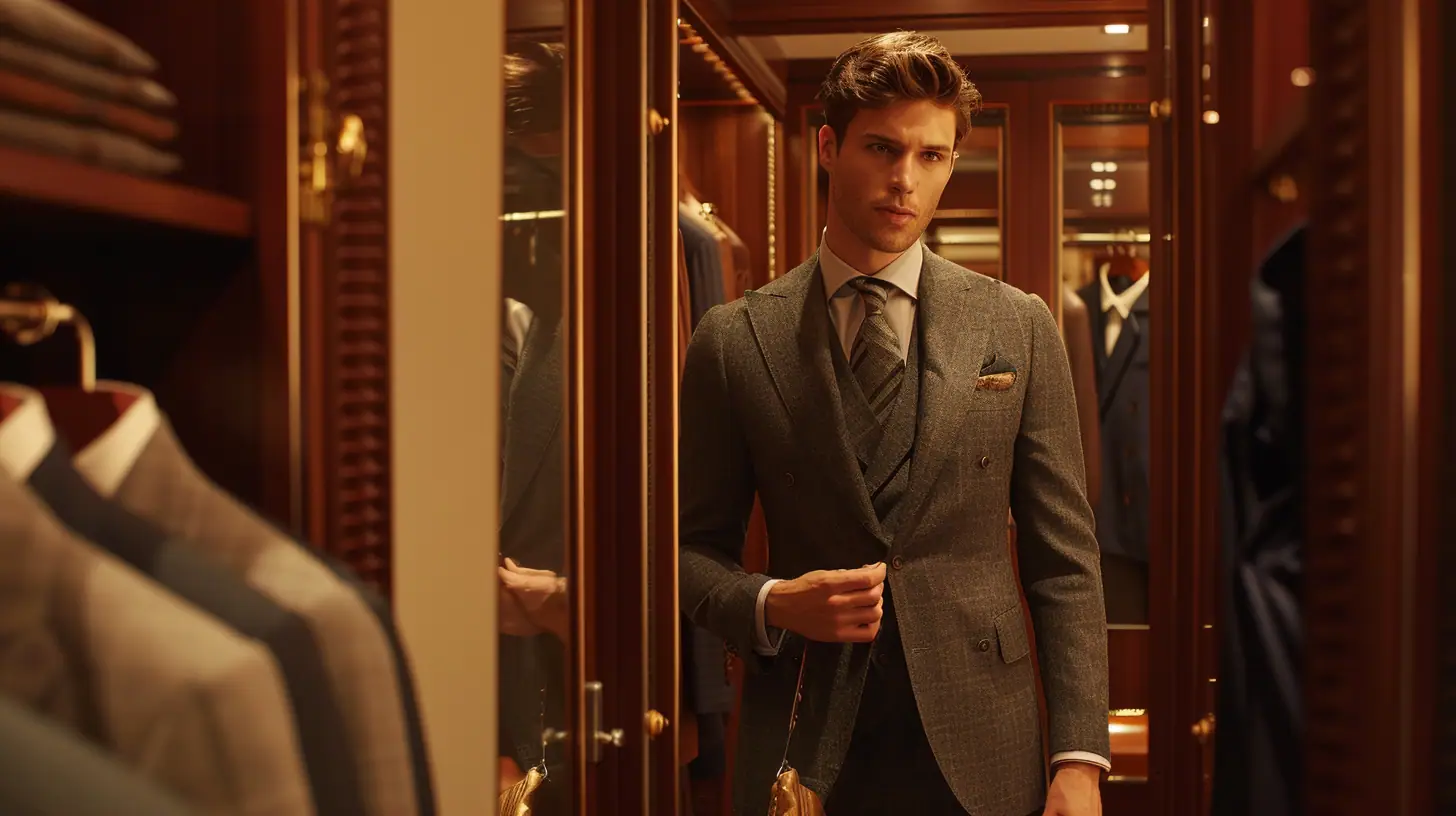
When buying a men’s suit, you’ll need to understand basic measurements, including chest size, shoulder width, sleeve length, and pants measurements. Start by determining your preferred fit – classic, modern, slim, or athletic – based on your body type. Focus on versatile colors like navy blue or charcoal gray for your first suit, and choose season-appropriate fabrics (lightweight for summer, heavier for winter). Set a realistic budget between $300-$1,000, factoring in alteration costs of $50-$150. Always prioritize quality construction and proper fit over brand names. A well-chosen suit can transform your professional appearance, and there’s much more to take into account in making the perfect selection.
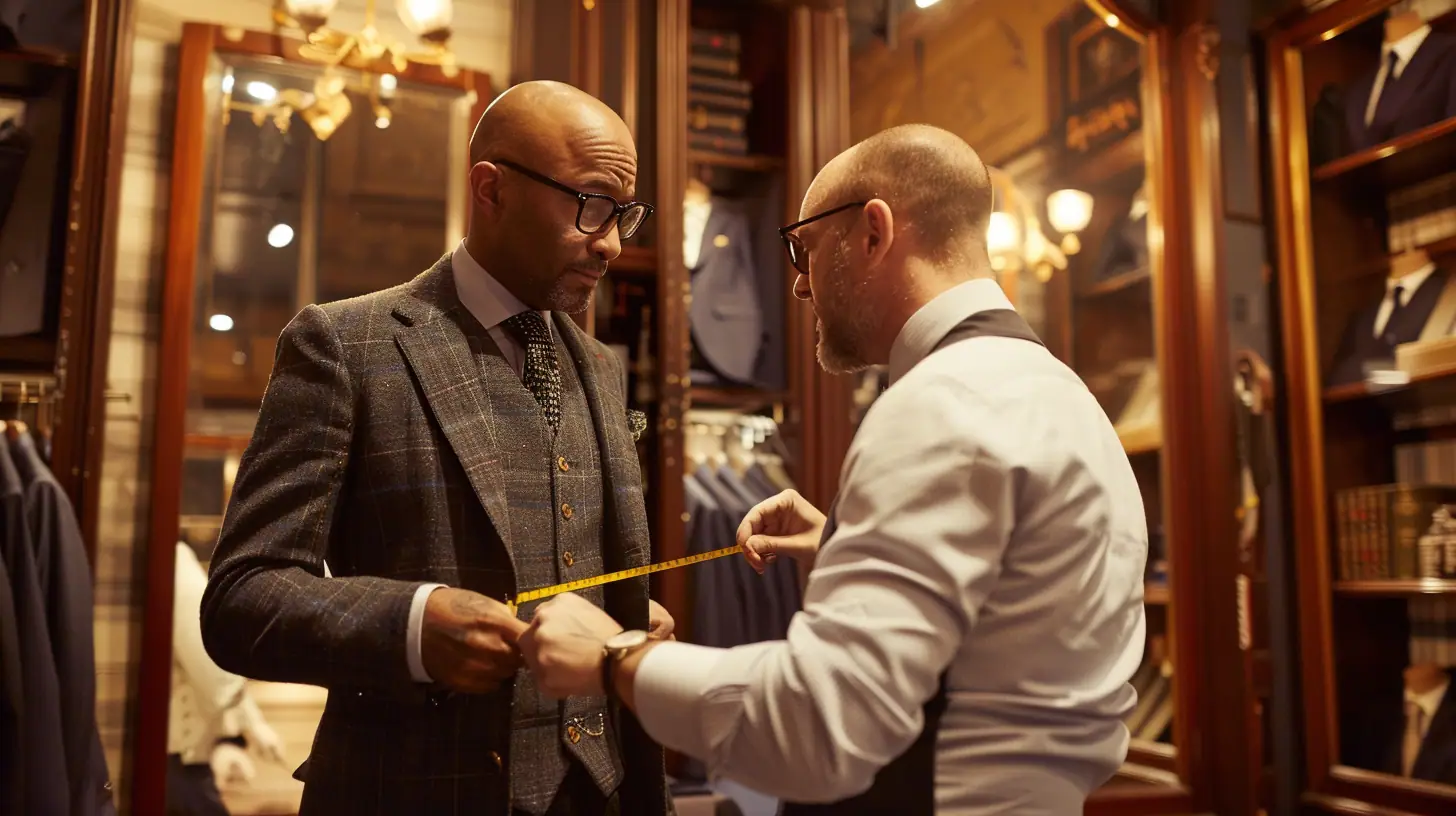
Before purchasing a suit, you’ll need to understand the basic measurement system used by tailors and retailers. Suit measurements follow a standardized format that combines your chest size with length proportions. For example, a suit labeled “40R” indicates a 40-inch chest measurement with a regular length.
Your chest size forms the foundation of suit sizing. Measure around the fullest part of your chest, just under your armpits, keeping the tape measure parallel to the ground. Next, determine your shoulder width by measuring from one shoulder point to the other across your back. These measurements will help guarantee the suit jacket fits properly across your upper body.
For pants, you’ll need both your waist measurement and inseam length. Measure your natural waist where you typically wear your pants, and determine your inseam by measuring from your crotch to where you want your pants to end. Most suit pants come unhemmed, allowing for customization to your preferred length.
Sleeve length is essential for a polished look. Measure from your shoulder point to just past your wrist bone, allowing about ½ inch of shirt cuff to show. Your fit preferences will influence these measurements – some men prefer a slim, modern fit while others opt for a classic, roomier cut.
Remember that these measurements serve as starting points. Different brands may vary slightly in their sizing, and you might need minor alterations to achieve the perfect fit. It’s always recommended to try on suits and consult with a professional tailor for precise measurements.
Suits come in three main fits: classic, modern, and slim. Each style offers distinct characteristics that’ll complement different body types and personal preferences. When you’re choosing a suit fit, consider both your body shape and the image you want to project.
| Fit Type | Characteristics | Best For |
|---|---|---|
| Classic Fit | Relaxed cut, roomy chest, straight legs | Traditional business, fuller figures |
| Modern Fit | Slightly tapered waist, trimmer legs | Most body types, versatile wear |
| Slim Fit | Narrow shoulders, tight waist, skinny legs | Lean builds, contemporary style |
| Athletic Fit | Broader shoulders, tapered waist | Muscular builds, V-shaped torsos |
The classic fit (sometimes called regular fit) provides the most generous cut through the chest, waist, and legs. You’ll find more room for movement and a traditional appearance that’s ideal for conservative settings. The modern fit offers a middle ground, with a slightly tailored silhouette that’s not too loose or tight. It’s considered the most versatile option for most men.
If you’re looking for a contemporary appearance, the slim fit creates a sharp, streamlined silhouette. This style hugs your body more closely and works best if you have a lean build. For those with athletic builds, consider an athletic fit suit, which provides extra room in the chest and shoulders while maintaining a tailored waist. Avoid oversized fits unless you’re specifically going for a fashion-forward, avant-garde look, as they can appear sloppy in most professional settings.
Fabric selection plays an essential role in how your suit looks, feels, and performs. You’ll need to take into account several key factors when choosing your suit’s material to make sure you’re making the right investment for your needs.
Start by examining fabric weight, which determines when and where you can wear your suit. Lightweight fabrics (7-9 oz) work well in warm weather, while medium-weight (10-12 oz) suits offer year-round versatility. Heavier fabrics (13+ oz) provide warmth and durability for colder climates.
Reflect on fabric durability based on your wearing frequency. Pure wool suits typically last longer than synthetic options, while fabric blends like wool-polyester can offer enhanced resistance to wrinkles and daily wear. For frequent use, choose tightly woven materials that can withstand regular movement and maintain their shape.
Fabric breathability matters for comfort. Natural fibers like wool, cotton, and linen allow air circulation, while synthetic materials may trap heat. If you’re often in warm environments, prioritize breathable options to stay comfortable throughout the day.
Pay attention to fabric texture and fabric patterns. Smoother finishes appear more formal, while textured materials like tweed or herringbone suit casual settings. Solid colors offer versatility, while patterns require more careful coordination with other garments.
Don’t overlook fabric care requirements. Some materials need dry cleaning, while others are machine washable.
Think about fabric sourcing too – higher-quality materials from reputable mills typically offer better performance and longevity, though they’ll cost more initially.
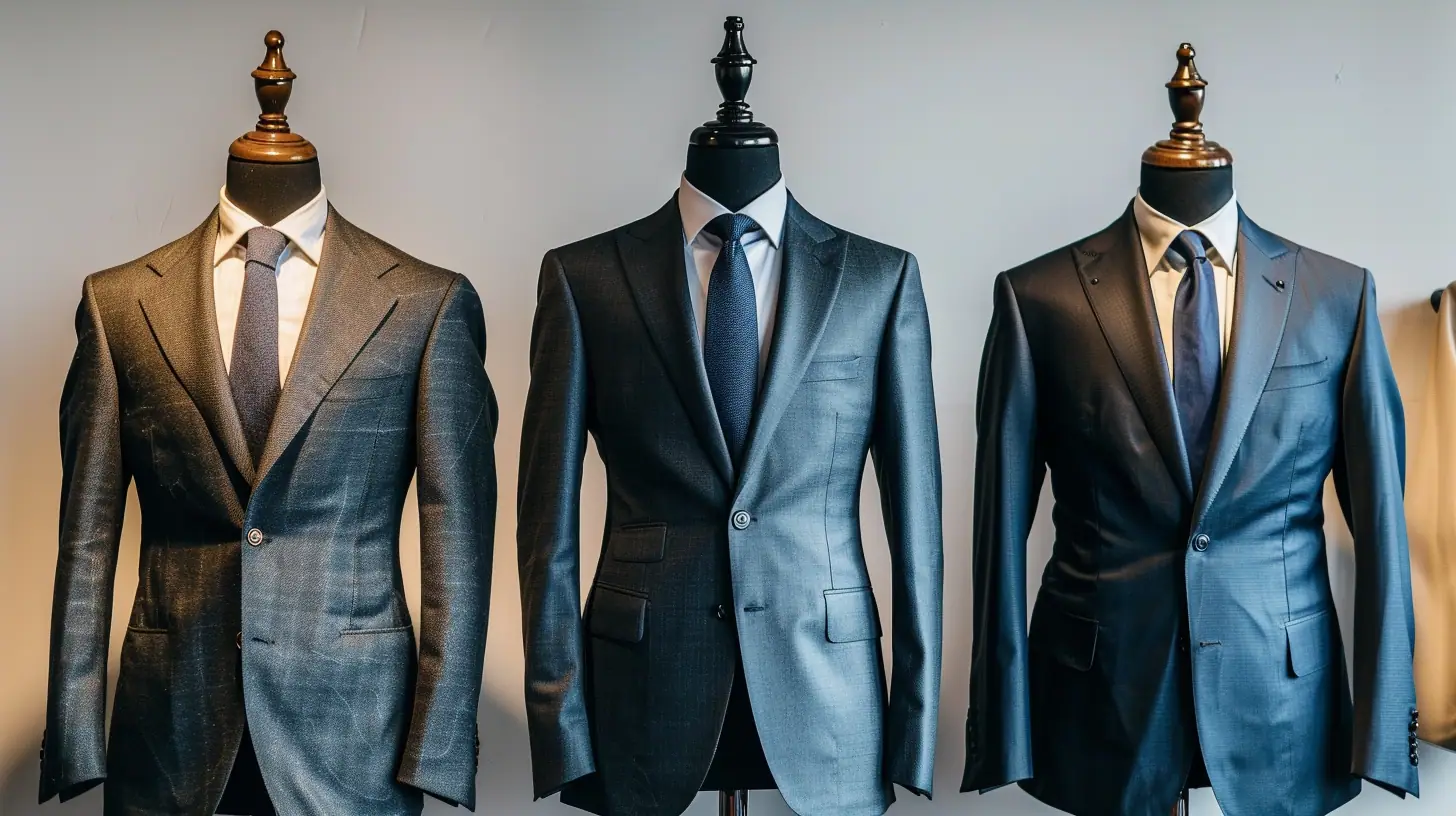
While fabric selection forms the foundation of a great suit, color choice determines its versatility and impact. If you’re building a suit wardrobe, start with versatile, timeless colors that align with both color psychology and your professional needs.
Navy blue should be your first suit color choice. It’s universally flattering, projects authority, and works for nearly every occasion, from job interviews to weddings. Navy’s rich depth communicates trustworthiness while maintaining a modern edge.
Your second essential color should be charcoal gray, which offers similar versatility but with a more understated presence.
Once you’ve secured these basics, consider medium gray or true black. Medium gray suits excel in daytime events and casual business settings, while black suits are ideal for formal evening occasions and somber events.
Though seasonal trends may tempt you toward bold colors, remember that classic choices guarantee longevity in your wardrobe.
For your third or fourth suit, you might explore lighter grays, subtle pinstripes, or deep brown tones. These choices add variety while maintaining professionalism. Light gray suits work particularly well in spring and summer, while brown suits can create a sophisticated look for fall.
Avoid trendy colors like bright blue or burgundy for your first few suits. While these may align with current seasonal trends, they’ll limit your suit’s versatility and could quickly look dated.
Instead, focus on building a foundation of classic colors that you can accent with bold ties and pocket squares.
Properly budgeting for a suit involves more than just finding the lowest price tag. You’ll need to take into account the suit’s purpose, quality, and long-term value when establishing your suit budget. Entry-level suits typically range from $300-$500, mid-range options from $500-$1,000, and premium suits can exceed $1,000.
When planning your budget, factor in alterations, which usually cost $50-$150 depending on the needed adjustments. Don’t forget about accessories like dress shirts, ties, and shoes that complement your suit. A cost comparison between different retailers and brands can help you find the best value within your price range.
Reflect on the suit’s intended use when setting your budget. If you’ll wear it frequently for work, investing in a higher-quality suit might save money in the long run. For occasional use, a more modest budget might suffice. Remember that seasonal sales can offer significant savings on quality suits.
Quality indicators that justify a higher suit budget include natural fibers like wool, hand-stitched details, and full canvas construction. These features typically increase durability and improve the suit’s appearance over time.
If you’re on a tight budget, look for suits with partial canvas construction and wool blends, which offer decent quality at lower price points.
Start your suit shopping with a clear maximum budget, but remain flexible within that range to accommodate unexpected finds. You’re better off spending slightly more on a well-fitting, quality suit than settling for an ill-fitting cheaper option that you’ll need to replace sooner.
The choice of suit material and weight directly affects your comfort throughout the year’s changing temperatures. When selecting a suit, you’ll need to take into account both weather considerations and event appropriateness to make a smart investment.
For summer fabrics, opt for lightweight materials like cotton, linen, or tropical wool that typically weigh between 7-9 ounces per yard. These breathable options help you stay cool during warm weather while maintaining a professional appearance. Light grays, tans, and seasonal colors like light blue work well for summer suits.
Winter layers demand heavier fabrics, usually between 12-14 ounces per yard. Wool, flannel, and tweed suits provide necessary warmth and pair well with overcoats. Darker colors like charcoal, navy, and deep browns are traditional winter choices that complement the season.
Transitional styles bridge the gap between seasons. Medium-weight wool suits (10-11 ounces) work well in spring and fall, offering versatility as temperatures fluctuate. These suits often come in year-round colors like mid-gray or navy, making them practical investments.
Evaluate fabric weight carefully based on your local climate. If you’re in a region with mild winters, you mightn’t need the heaviest fabrics. Conversely, those in tropical areas should focus on lightweight, breathable options.
Remember that indoor heating and cooling can also affect your comfort, so think about where you’ll spend most of your time wearing the suit.
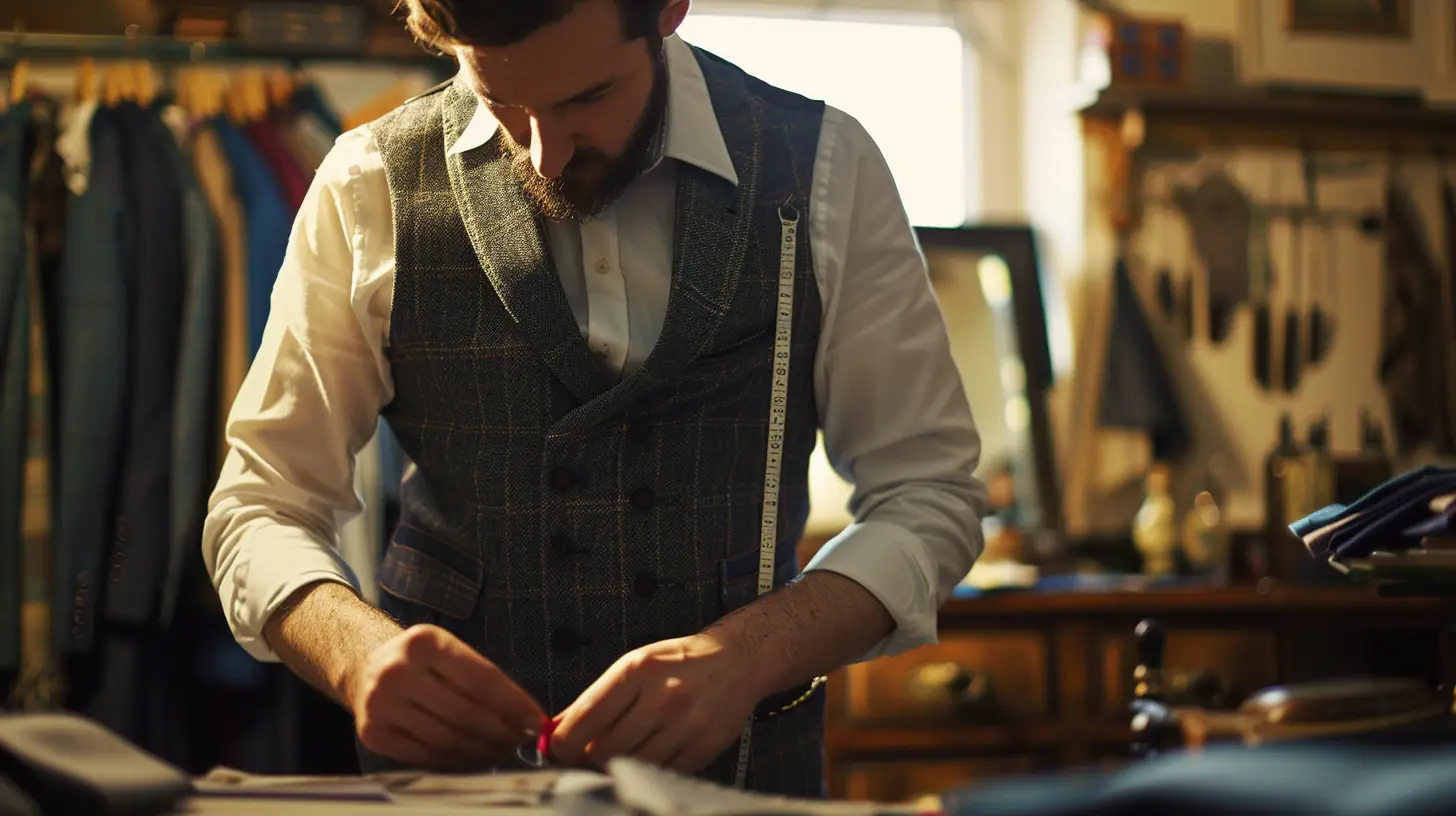
A skilled tailor can transform an off-the-rack suit into a custom-fitted masterpiece. When searching for a reliable tailor, you’ll want to take into account several key factors to guarantee you’re getting the best possible service. Start by researching tailor reputation through client testimonials and online reviews. Location convenience matters, but don’t let it be your primary deciding factor.
Schedule a style consultation to assess the tailor’s expertise and communication skills. During this meeting, discuss customization options and ask about their fabric sourcing practices. A professional tailor will guide you through the fitting process and explain their tailoring timeline.
| Service Aspect | What to Look For |
|---|---|
| Experience | 5+ years specializing in suits |
| Communication | Clear explanation of alterations |
| Equipment | Modern tools and workspace |
| Portfolio | Photos of previous work |
| Pricing | Transparent rates and estimates |
Before committing, guarantee there’s pricing transparency for all services. Most quality tailors will provide detailed quotes and explain potential additional costs. You should expect appointment scheduling to be professional and organized, with clear communication about fitting dates and completion times.
Ask about their approach to complex alterations and whether they have experience with your specific suit brand or fabric type. The best tailors maintain detailed client records and can accommodate future adjustments. Don’t hesitate to request references or examples of their previous work, particularly for extensive alterations. Remember, a good tailor becomes a valuable long-term partner in maintaining your professional wardrobe.
Understanding suit button styles stands as one of the most vital elements when selecting your perfect suit. You’ll encounter three main configurations: single-breasted suits with one, two, or three buttons, and double-breasted suits with four to six buttons.
The two-button suit remains the most versatile and popular choice. When wearing this style, you’ll follow the “sometimes, always, never” rule – button the top button when standing, always leave the bottom button undone.
For three-button suits, you’ll use the same principle: the top button is optional, the middle button stays fastened, and the bottom button remains open.
Button placement plays a fundamental role in your suit’s overall appearance. Higher button placement creates a lengthening effect for shorter men, while lower placement works well for taller frames. You’ll want the top button to sit just above your navel for the most flattering look.
Pay attention to button materials, as they contribute considerably to your suit’s quality and appearance. Horn buttons, particularly those made from buffalo horn, offer durability and a luxurious look.
Plastic buttons, while more affordable, don’t provide the same sophistication. Mother-of-pearl buttons add an elegant touch but require more careful maintenance.
For double-breasted suits, you’ll typically fasten the top button and leave the bottom row undone. The peak lapels and overlapping front panels create a more formal, distinguished appearance, making these suits ideal for business and formal occasions.
Just as buttons define a suit’s functionality, lapels shape its character and style. When choosing a suit, you’ll encounter three main lapel variations, each lending a distinct aesthetic to your garment. Understanding these styles will help you make an informed decision that matches your intended use and personal taste.
| Lapel Type | Characteristics | Best For | Style Level |
|---|---|---|---|
| Notch Lapels | Standard V-shaped notch | Business, everyday | Conservative |
| Peak Lapels | Upward-pointing edges | Formal events | Bold |
| Shawl Lapels | Continuous curve | Black tie, tuxedos | Elegant |
| Double-Breasted | Wider, prominent | Power suits | Assertive |
Beyond the basic lapel types, you’ll need to take into account lapel width, which should proportionally match your body type and the current fashion trends. Wider lapels create a bold statement, while narrower ones offer a more modern look. Pay attention to lapel stitching, as it affects both durability and aesthetics.
For added versatility, you might contemplate suits with contrasting lapels or reversible lapels, though these are less common in traditional business settings. Don’t forget to examine the lapel buttonholes – a working buttonhole on the left lapel indicates higher quality tailoring, traditionally used for boutonnières. Regardless of your choice, verify the lapel lies flat against your chest without buckling or gaping, as this indicates proper fit and construction. The lapel’s roll from the collar to the first button should create a smooth, continuous line.
Suit jacket vents play an essential role in both comfort and style. These slits in the back of your jacket allow for better movement and help the garment drape properly when you’re sitting or walking. You’ll find three main types of vents in suit jacket styles: no vent, single vent, and double vent.
A no-vent jacket offers a sleek, fitted appearance but provides the least mobility. It’s best suited for slim-built men who don’t need extra room for movement. The jacket length typically sits close to the body, creating a streamlined silhouette that works well for formal occasions.
Single-vented jackets feature one slit up the center back and are the most common in American suit styles. While they provide more flexibility than no-vent options, they can reveal your backside when you put your hands in your pockets or sit down. The jacket length usually extends just enough to cover your seat.
Double-vented jackets, also known as side-vented, have two slits on either side of the back. This style originates from horseback riding traditions and offers the most mobility. They’re considered more sophisticated and are particularly common in British tailoring. The vents help the jacket drape cleanly whether you’re moving or seated.
When choosing your vent style, consider your body type and typical activities. If you’re active or frequently sit for long periods, you’ll appreciate the freedom of movement that double vents provide.
For a more contemporary look, single vents work well, while no vents suit those seeking a modern, streamlined appearance.
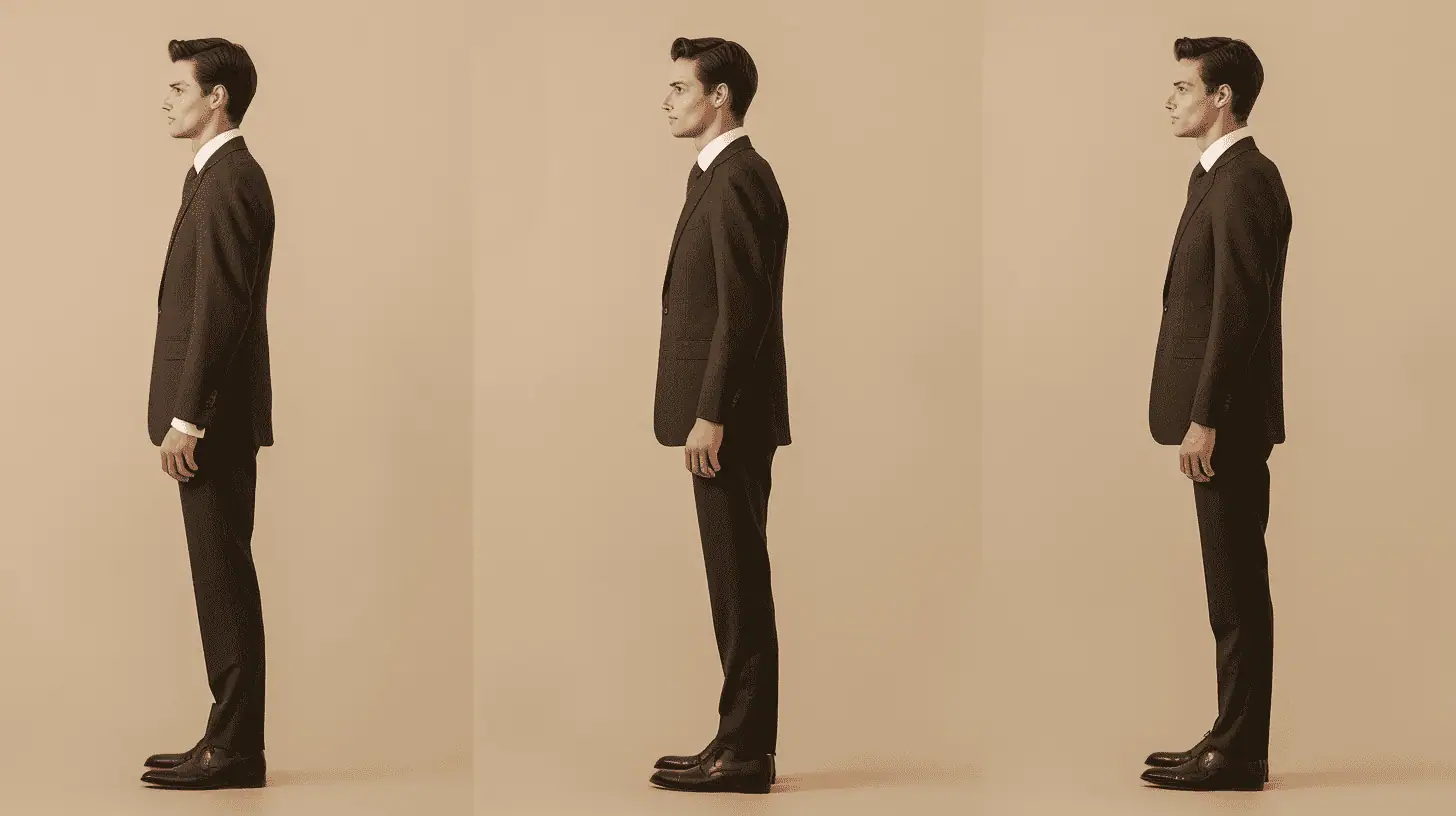
The break in your trousers – where the fabric meets your shoes – dramatically impacts your suit’s overall appearance. When selecting trouser lengths, you’ll need to choose between four main break options: no break, slight break, medium break, and full break.
A no-break style falls just above your shoe, creating a clean, modern look that’s perfect for slim trouser fits and contemporary trouser patterns. The slight break allows the fabric to barely touch your shoe’s upper, causing a small ripple – ideal for most trouser fabrics and business settings.
A medium break creates a single fold in the fabric where it meets your shoe, offering a classic look that works well with various trouser colors and traditional styles. The full break results in multiple fabric folds at the shoe, a traditional option that’s becoming less common in modern suiting.
When choosing your break, consider how trouser linings affect the drape and how different trouser styles complement your body type. The break you select should also coordinate with your trouser pockets and overall suit silhouette.
Your tailor can adjust the break by hemming your trousers to the proper length. For the most versatile option, choose a slight or medium break – these work well across formal and casual settings.
Remember that wider-leg trousers typically require more break than slim-fit styles to maintain proper proportions and avoid awkward bunching or floating above the shoe.
When examining a suit beyond its visible length and break, understanding construction quality markers helps you make a smart investment.
First, check the stitching along the seams. Quality suits feature tight, consistent stitch quality with even spacing and no loose threads. Look for roughly 8-12 stitches per inch – this indicates durability and craftsmanship.
Check the suit’s canvas construction by pinching the lapel between your thumb and forefinger. A full-canvas or half-canvas suit will feel slightly cushioned and spring back to shape. Fused suits feel stiff and paper-like, indicating lower quality.
The fabric weight should match the suit’s intended use – lighter weights (7-9 oz) for summer, medium weights (10-12 oz) for year-round wear.
Examine the buttonholes, particularly on the sleeve cuffs. Well-made suits have working buttonholes (called “surgeon’s cuffs”) with neat stitching. The buttons themselves should be securely attached with a strong thread shank.
Inside the jacket, look for a clean lining attachment with no puckering or visible machine marks.
Test the suit’s roll by gently folding the lapel. Quality suits maintain their shape due to proper internal construction. The collar should sit flush against your neck without gapping, and the shoulders should have a smooth shift from padding to sleeve.
Pattern matching at the seams, particularly on striped or plaid suits, indicates attention to detail and superior construction standards.
Even after finding a suit that fits well overall, most men need some alterations to achieve the perfect fit. Understanding common suit alterations will help you make informed decisions and budget appropriately when purchasing your next suit.
Most alterations fall into two categories: simple adjustments that any tailor can handle, and complex changes that require significant reconstruction. Simple alterations are typically affordable and won’t compromise the suit’s structure. Complex alterations can be expensive and mightn’t be worth the investment.
Common simple alterations include:
More complex alterations, like major shoulder padding modifications or jacket shortening, often require partial deconstruction of the garment. These changes can affect the suit’s balance and may cost as much as a new suit.
Lining replacements are also considered complex alterations, though they’re sometimes necessary to extend a suit’s life.
When shopping, focus on suits that fit well in the shoulders and chest, as these areas are the most difficult and expensive to alter.
You’ll save money and achieve better results by choosing a suit that only needs minor adjustments in easier-to-alter areas like the sleeves, waist, and trouser length.
Proper accessories along with thoughtful matching can transform a basic suit into a polished, sophisticated ensemble. Your choice of accessories will define your personal style while adhering to classic menswear principles. When selecting tie options, consider both width and length – your tie should reach your belt buckle and match your lapel width.
| Essential Accessory | Matching Guidelines |
|---|---|
| Dress Shirt | Choose white or light blue for versatility; collar should complement lapel style |
| Tie Options | Match tie width to lapel width; avoid competing patterns with shirt |
| Pocket Square | Complement but don’t exactly match tie; fold based on formality |
| Belt & Shoes | Always match leather colors; metals should coordinate with watch |
You’ll want to coordinate metals across your accessories – your watch, cufflinks, and belt buckle should share similar tones. When wearing a pocket square, don’t match it exactly to your tie; instead, choose one that complements the overall color scheme while adding visual interest.
For business settings, stick to classic combinations like navy suits with burgundy ties or charcoal suits with forest green accessories. You can express more personality through subtle pattern mixing, but maintain balance – if your suit has bold stripes, keep your tie pattern minimal. Remember that your accessories shouldn’t compete for attention but rather work together to create a cohesive look. When in doubt, start with solid colors and basic patterns before experimenting with more complex combinations.
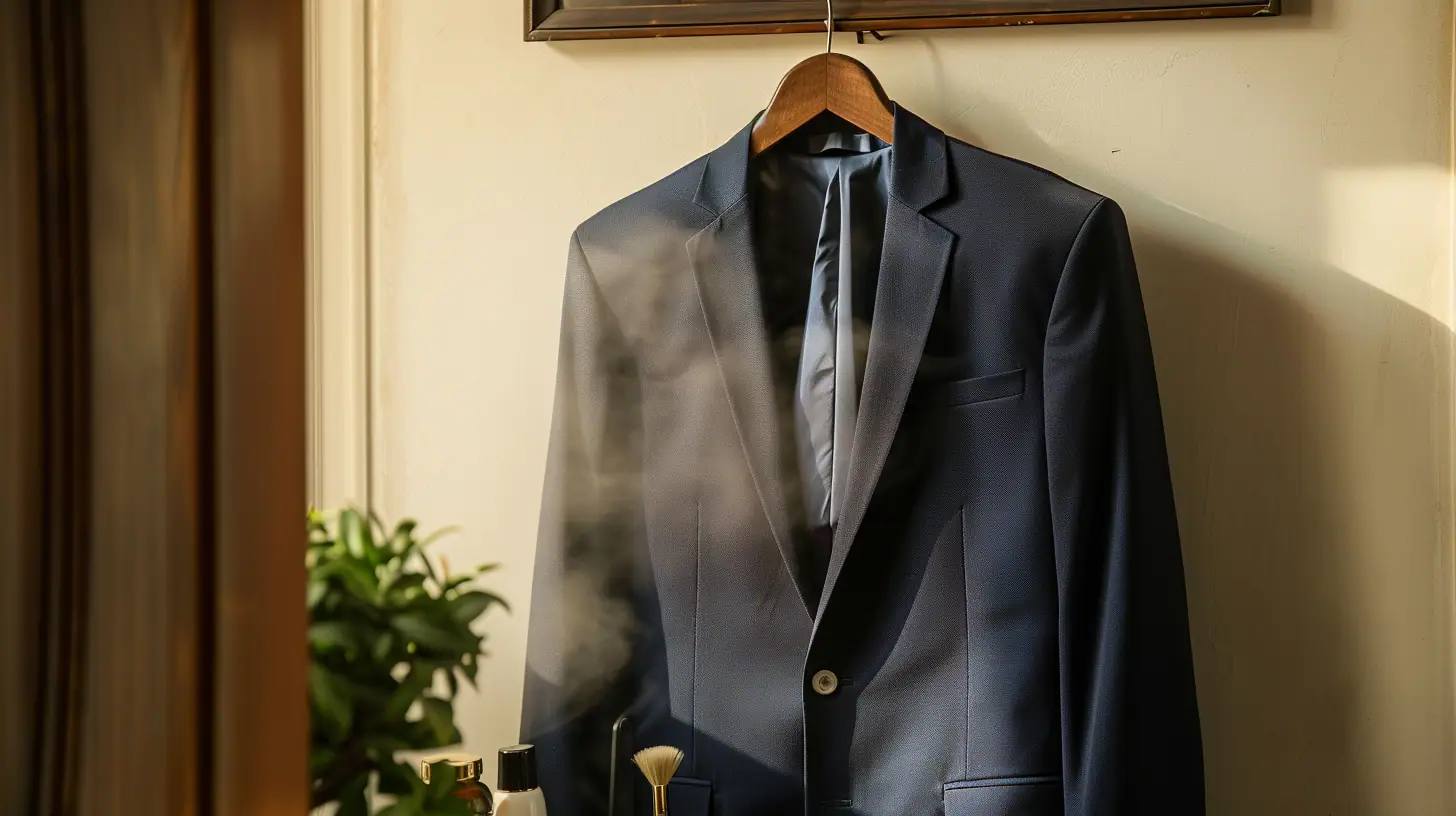
A well-maintained suit will serve you for years and retain its sharp appearance through countless wears. Proper care involves regular cleaning techniques and smart storage solutions to protect your investment. After each wear, brush your suit with a clothes brush to remove surface dirt and debris, and always allow it to air out for 24 hours before storing.
When it comes to cleaning, only dry clean your suit when necessary – typically every 4-6 wears or when visibly soiled. Over-cleaning can damage the fabric and compromise the suit’s structure. Between professional cleanings, spot clean minor stains with a damp cloth and carefully steam out wrinkles using a garment steamer.
Your suit’s storage solutions are vital for maintaining its shape and preventing damage. Use these essential practices:
Don’t forget to rotate your suits regularly if you wear them frequently. You’ll want to give each suit at least 24 hours of rest between wears to allow the fabric to recover and wrinkles to release naturally.
For travel, invest in a quality garment bag and learn proper folding techniques to minimize creasing during transport.
A well-maintained suit’s lifespan typically ranges from 3-5 years with regular wear.
You’ll know it’s time for replacement when you notice clear signs like shiny fabric, frayed edges, or loose seams that can’t be repaired.
If you rotate between multiple suits and care for them properly (dry cleaning, proper storage), you can extend their life up to 7 years.
Watch for shoulder divots and stretched fabric as key signs replacement is needed.
While traditional formal events call for a tie, you’ll find today’s dress codes are becoming more flexible.
You can confidently go tie-less if you elevate your look with suit alternatives like a crisp dress shirt, turtleneck, or fine-knit sweater.
Just make sure your collar stays neat and consider tie options like a silk scarf or an ascot for added sophistication.
Yes, you can absolutely buy a second-hand suit!
Just make sure to check the suit condition carefully – look for signs of wear, stains, or damage, particularly around the seams and high-stress areas.
The suit size must fit you properly, as alterations can be limited on used garments.
You’ll find great deals at consignment shops, thrift stores, and online marketplaces.
Many high-quality suits are available second-hand at a fraction of retail prices.
Oh, you’re that person who wears the same outfit every day like a cartoon character! Just kidding.
While there’s nothing technically wrong with buying identical suits, you’ll limit your suit versatility. Instead, you should build a wardrobe with different suit colors and styles.
Start with versatile options like navy and charcoal, then branch out. You’ll find more confidence and opportunities when you can match your suit to different occasions.
It’s generally not recommended to pair brown shoes with a black suit, as this combination breaks traditional shoe color combinations in menswear.
While current suit fashion trends are becoming more flexible, black suits specifically demand black shoes to maintain formal elegance.
If you’re looking to wear brown shoes, you’ll want to choose navy, gray, or brown suits instead.
Save your brown shoes for these more versatile suit colors.
Buying a suit doesn’t have to make you sweat bullets. Armed with knowledge about measurements, fits, fabrics, and quality indicators, you’ll make smarter choices for your wardrobe. Remember to stay within your budget while investing in proper alterations and maintenance. When you nail these fundamentals and pair them with the right accessories, you’ll look sharp and feel confident in your perfectly tailored suit.



